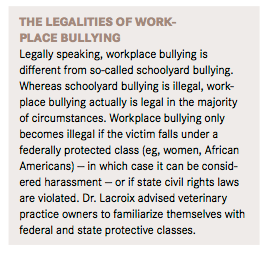Exploring Workplace Bullying
Bullying — a common problem among health care workers — is detrimental to both employee morale and your bottom line. Here’s what you need to know.

According to the Workplace Bullying Institute (WBI), workplace bullying is defined as the “repeated mistreatment of one or more employees with the intent of humiliation, intimidation and sabotage of performance.” Bullying is a productivity killer — costing an estimated $200 billion per year in decreased output, increased absenteeism and high turnover — according to recent research.
According to a 2014 WBI survey (the newest survey results will be published later this year), 65.6 million Americans have either been bullied at work or have witnessed someone being bullied at work. What’s more, survey respondents reported that health care was the most common industry in which bullying occurs.
Workplace bullying is usually deliberate and hurtful with the intent to control others. Managers and supervisors are often the perpetrators of workplace bullying, but this behavior can be found at any organizational level. Workplace bullying can include isolating employees from opportunities, information and social interaction; frequently reminding employees of their mistakes; not giving employees credit for their work; insulting and gossiping about employees; and setting up employees to fail (e.g., impossible deadlines). (See Recognizing Workplace Bullies.)
At the 2017 Western Veterinary Conference in Las Vegas, Charlotte Lacroix, DVM, JD, discussed workplace bullying, including how it pertains to employee motivation, with a focus on defining it, discussing its legal framework, and implementing strategies for defending against it in veterinary practices.

Identifying Employee Motivation
According to Dr. Lacroix, workplace bullying falls within a motivational context. Ideally, employees are motivated to work at their chosen workplace and actively pursue that workplace’s goals and objectives; they do not believe their workplace is, as Dr. Lacroix said, “just a place to work and get a paycheck.”
Once basic work motivations (i.e., good base pay and benefits) are met, employees seek other motivations, including:
- Opportunities to achieve, improve skills and advance professionally
- Job fulfillment and intellectual stimulation
- Recognition for good work
Not all employees are motivated by the same things, though. Developing individualized motivation plans can help practice owners gain insight into the sources of each of their employees’ motivations. In addition to meeting general and specific employee motivations, it is important for a practice’s leadership to demonstrate their own motivation by remaining positive and inspired by what they do.
Recognizing a Problem
Keeping a pulse on what’s really going on within a practice can help that practice’s leadership recognize problems such as bullying. Internal employee surveys are a great diagnostic tool for finding out what’s happening behind the scenes. On a humorous note, Dr. Lacroix likened these surveys to fecal samples: The fecal sample can detect a problem that may not be visible on the outside.
Workplace bullying is usually a sign of a larger problem and can be tied to the perpetrator’s lack of motivation to work. When the bullying becomes apparent, the practice’s leadership should consider these questions:
- Why is that employee not motivated to work?
- Is there anything about the practice or practice culture that fosters bullying?
Managing Motivation Killers
Motivation killers — “bullies, negative Nancys, and poor performers,” according to Dr. Lacroix — are toxic employees who do not align themselves with the workplace culture, typically to the workplace’s detriment. It is important to talk with these employees to learn why they’re not happy at work and to see if anything can be done to improve their work experience. Asking them “why”-focused questions can reveal the source of unhappiness or possibly bring to light unsubstantiated complaints or accusations about other employees.
Dr. Lacroix advised being judicious when speaking to and managing motivation killers. If their behaviors are intolerable according to the practice’s culture, though, it may be best to let them go. Admittedly, she acknowledged, this can be easier said than done, especially if the employee has technical expertise that is vital to practice operations. However, firing a toxic employee may have to be the cost of doing business, maintaining a positive workplace culture, and keeping other employees motivated.

Creating an Anti-Bullying Policy
According to Dr. Lacroix, the best defense against workplace bullying is a clearly worded policy that is part of the employee manual. A good anti-bullying policy should include:
- A clear definition of workplace bullying
- An outline of how to report bullying, particularly when the bully is the manager
- A detailed description of the investigation process
- A list of consequences for not following the policy
- A no-retaliation clause
Discussing Bullying Behavior
If an employee is accused of bullying, the practice owner or manager should speak with that employee. Dr. Lacroix emphasized that “every sit-down conversation must be documented in the employee’s file.” This document should follow a template:
- Date and time span of the conversation
- Full names and titles of meeting attendees
- Reason for meeting (e.g., discussion of how employee’s behavior was materially detrimental to practice operations)
- Memo section in “SOAP” format (subjective data, objective data, assessment and plan) about the bullying behavior
In addition to having individual meetings, Dr. Lacroix suggested having discussions about bullying with the entire staff. These discussions, which should also be documented, would help get all employees on the same page about bullying and sensitize them to that behavior.
Dr. JoAnna Pendergrass received her doctorate in veterinary medicine from the Virginia-Maryland College of Veterinary Medicine. Following veterinary school, she completed a postdoctoral fellowship at Emory University’s Yerkes National Primate Research Center. Dr. Pendergrass is the founder and owner of JPen Communications, LLC, a medical communications company.
